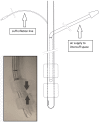An endotracheal tube providing "pressurized sealing" prevents fluid leakage in mechanically ventilated critically ill patients: a pilot study
- PMID: 31691046
- PMCID: PMC7224017
- DOI: 10.1007/s00540-019-02707-4
An endotracheal tube providing "pressurized sealing" prevents fluid leakage in mechanically ventilated critically ill patients: a pilot study
Abstract
Microaspiration of bacteriologically contaminated oropharyngeal secretions alongside the cuff of an endotracheal tube (ETT) is a key mechanism for development of ventilator-associated pneumonia. We have constructed a prototype double-cuffed ETT equipped with a supplemental port in-between the cuffs through which continuous positive airway pressure (CPAP) is delivered. Pressure in the intercuff space propels secretions upwards and produces 100% tracheal sealing in an in vitro model. We conducted a 24 h study to investigate the sealing effect of this ETT in 12 critically ill mechanically ventilated patients. Methylene blue, instilled through a bronchoscope on top of the proximal cuff, was used as leakage tracer. Fiberoptic visualisation of the trachea was performed 1 h and 24 h thereafter. Leakage was confirmed if blue dye was detected on the tracheal mucosa beyond the tip of the ETT. In no patient, dye passed by the cuffs during the study period. Presence of the ETT did not interfere with ventilator settings, patient mobilization, physiotherapy, and technical acts. Overall, pressures in the intercuff space remained between 10 and 15 cmH2O. Excessive pressure swings were swiftly corrected by the CPAP system. A double-cuffed ETT, offering "pressurized sealing" of the trachea, safely and effectively prevented leakage during 24 h mechanical ventilation.
Keywords: Critically ill; Cuff; Double-cuffed; Endotracheal tube; Leakage; Mechanical ventilation; Microaspiration; Ventilator-associated pneumonia.
Figures


References
-
- Pneumatikos IA, Dragoumanis CK, Bouros DE. Ventilator-associated pneumonia or endotracheal tube-associated pneumonia? An approach to the pathogenesis and preventive strategies emphasizing the importance of endotracheal tube. Anesthesiology. 2009;110:673–680. doi: 10.1097/ALN.0b013e31819868e0. - DOI - PubMed
Publication types
MeSH terms
Associated data
LinkOut - more resources
Full Text Sources

